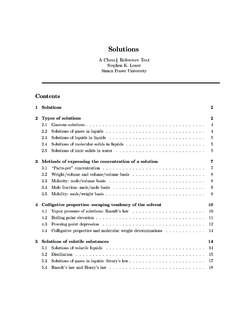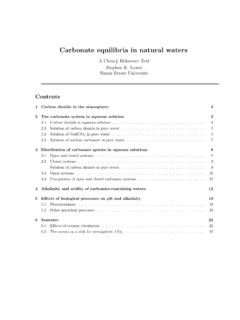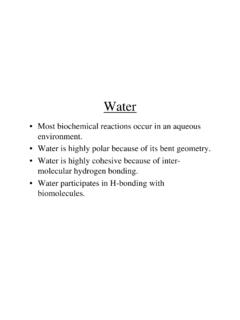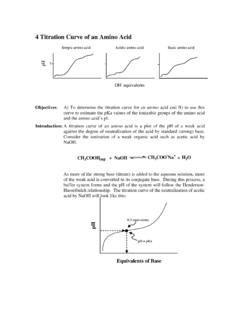Transcription of Acid-base Equilibria and Calculations - Chem1
1 Acid-base Equilibria and CalculationsA Chem1 Reference TextStephen K. LowerSimon Fraser UniversityContents1 Proton donor-acceptor The ion product of acid and base The fall of the Proton sources and Leveling Dissociation of weak Strong Proton free energy and Quantitative treatment of Acid-base Strong acids and Concentrated solutions of strong Weak monoprotic Pure acid in Weak Carrying out Acid-base the quadratic and higher-order Calculations on mixtures of Mixture of an acid and its conjugate base : Ionization Calculations involving mixtures of acids and Diprotic of an ampholyte Acid-base Titration Observation of equivalence Detection of the equivalence CONTENTS5 acid - and base neutralizing capacity346 Graphical treatment of Acid-base Log-Cvs pH the lines on the Estimating the pH on logCvspH of an acid in pure of a solution of the conjugate Acid-base chemistry in Maintenance of Acid-base Disturbances of Acid-base acid rain419 The carbonate The geochemical carbon Carbon dioxide in the Dissolution of CO2in Distribution of carbonate species in aqueous Calculations on carbonate Chemistry Reference Text2 Acid-base Equilibria and Calculations CONTENTSAcid- base
2 Reactions, in which protons are exchanged between donor molecules (acids)and acceptors (bases), form the basis of the most common kinds of equilibrium problemswhich you will encounter in almost any application of document provides a reasonably thorough treatment of aquatic-solution acid -baseequilibria. Although it has been used as the principal text for part of a university-levelGeneral Chemistry course, it can also serve as a reference for teachers and advancedstudents who seek a more comprehensive treatment of the subject than is likely to befound in conventional background, we will assume that you already have some understanding of thefollowing topics: The Arrhenius concept of acids and bases the Br nsted-Lowry concept, conjugate acids and bases titration definition of pH and the pH scale acids and bases the names of the common acids and basesChem1 General Chemistry Reference Text3 Acid-base Equilibria and Calculations 1 Proton donor-acceptor equilibria1 Proton donor-acceptor equilibriaIn order to describe Acid-base Equilibria in the most general way, we will often represent an acid by theformula HA and its conjugate base as A.
3 The actual electric charges of the species will of course dependon the particular nature of A, but the base will always have one more negative charge than the acid pair of species constitutes anacid- base systemwhose two members are related by the reactionHA(aq) H++A (1)The most fundamental property of a given Acid-base system is the extent of the above reaction. Ifthe concentration of undissociated HA is negligible when the reaction is at equilibrium, the acid is saidto bestrong. Only a very small number of acids fall into this category; most acids are two complications that immediately confront us when we attempt to treat Acid-base equi-libria in a quantitative way:1. Since protons cannot exist in solution as independent species, the tendency of an acid or a baseto donate or accept a proton (as in Eq 1) cannot be measured for individual acid or base speciesseparately; the best we can do is compare two diDerent Acid-base systems, and determine the extentto which the bases are able to compete against each other for the Water itself can act both as an acid and a base , and most of the practical applications of acid -basechemistry are those involving aqueous solutions.
4 This means that whenever we are studing anaqueous solution of an acid HA, we must also contend with the conjugate acid and base of can make use of (2) to help us out with (1) by using water as a reference standard for proton-donatingand -accepting power. Thus the strength of an acid HA can be defined by the equilibriumHA + H2O H3O++A Ka(2)Similarly, the strength of the base A is defined byA +H2O HA + OH Kb(3)Note carefully that reaction (3) isnotthe reverse of (2). The ion product of waterIn pure water, about one H2O molecule out of 109is dissociated :H2O H++ OH The actual reaction, of course, is the proton transferH2O+H2O H3O++ OH (4)for which the equilibrium constantKw= [H3O+][OH ](5)is known as theion productof water. The value ofKwat room temperature is 10 pure water, the concentrations of H3O+and OH must of course be the same:[H3O+] = [OH ]= Kw 10 7a solution in which [H3O+] = [OH ] is said to Chemistry Reference Text4 Acid-base Equilibria and Calculations The ion product of waterAs with any equilibrium constant, the value ofKwis a>ected by thetemperature(Kwundergoes a10-fold increase between 0 C and 60 C), by thepressure(Kwis about doubled at 1000 atm), andby the presence ofionic speciesin the solution.
5 Because most practical Calculations involvingKwrefer to ionic solutions rather than to pure water, the common practice of using 10 14as if it werea universal constant is unwise; under the conditions commonly encountered in the laboratory, pKwcan vary from about 11 to almost 151. In seawater,Kwis 10 that under conditions whenKwdi>ers significantly from 10 14, the pH of a neutralsolution will not be For example, at a pressure of 93 kbar and 527 C,Kw= 10 , the pH ofpure water would be Such conditions might conceivably apply to deposits of water in geologicalformations and in undersea Example 1At 60 C, the ion product of water is What is the pH of a neutral solution at this tempera-ture?Solution:Under these conditions, [H+][OH ] = 14.
6 If the solution is neutral, [H+]=[OH ]= 14, corresponding to pH = Stephen J. Hawkes: pKwis almost never , J. Chem. Education 1995: 72(9) 799-802 Chem1 General Chemistry Reference Text5 Acid-base Equilibria and Calculations acid and base acid and base strengthsThe equilibrium constants that define the strengths of an acid and of a base areKa=[H3O+][OH ][HA](6)andKb=[HA][OH ][A ](7)How areKaandKbrelated? The answer can be found by adding Equations 2 and 3:HA H++A (8)A +H2O HA + OH (9)H2O H++ OH (10)Since the sum of the first two equations represents the dissociation of water (we are using H+instead ofH3O+for simplicity), the equilibrium constant for the third reaction must be the product of the first twoequilibrium constants:KaKb=Kw(11)Clearly, as the strength of a series of acids increases, the strengths of their conjugate bases will decrease,hence the inverse relation valuesYou will recall that the pH scale serves as a convenient means of compressing a wide rangeof [H+] -values into a small range of numbers.
7 Just as we defined the pH as the negative logarithm of thehydrogen ion concentration, we can definepK= logKfor any equilibrium constant. acid and base strengths are very frequently expressed in terms of pKaandpKb. From Eq 11 it should be apparent thatpKa+pKb=pKw(= at 25 C)Table 1 on the next page gives the pKvalues for a number of commonly-encountered Acid-base systemswhich are listed in order of decreasing acid strength. Take a moment to locate the H3O+/H2O systemin this table. Notice the value of pKafor the hydronium ion; its value of 0 corresponds toKa= 1. Anyacid whoseKaexceeds that of the hydronium ion is by definition a strong acid . You will also notice thatthe pK s of the strongest acids and bases are given only approximate values; this is because these speciesare so strongly dissociated that the interactions between the resulting ions make it diHcult to accuratelydefine their concentrations in these Chemistry Reference Text6 Acid-base Equilibria and Calculations acid and base strengthsacidpKabasepKbHClO4perchloric acid 7 ClO 4 21 HClhydrogen chloride 3 Cl 17H2SO4sulfuric acid 3 HSO 4 17 HNO3nitric acid 1NO 315H3O+hydronium ion0H2O14H2SO3sulfurous H2PO [Fe(H2O)6]3+aquo ferric [Fe(H2O)5OH]2+ [Al(H2O)6]3+aquo aluminum [Al(H2O)5OH]2+ dissolved HS 4dihydrogen phosphate 3bisulfite SO2 B(OH) +4ammonium (OH)4o-silicic SiO(OH) CO2 4hydrogen PO3 (OH) SiO2(OH)
8 2 0HS bisulfidec 19 S2 5NH3ammonia 23 NH 2 9OH hydroxide ion 24 O2 10aThe acid H2CO3is only a minority species in aqueous carbon dioxide solutions, which contain mainly CO2(aq).The pKaof that is commonly given is calculated on the basis of the total CO2in the solution. The true pKaofH2CO3is about water is acting as asolute, as it must if the acid strength of H2O is being compared with that of other veryweak acids, then pKa 16 should be used. SeeJ. Chem. Education1990: 67(5) tables still give 14 as pK2for H2S; this is now known to be 1: pKvalues of acids and bases in aqueous solutions at 25 CChem1 General Chemistry Reference Text7 Acid-base Equilibria and Calculations acid and base strengths Table 2: Free energy diagram for acids and bases in aqueous Chemistry Reference Text8 Acid-base Equilibria and Calculations 2 The fall of the proton2 The fall of the protonAn acid , being a proton donor, can onlyactas an acid if there is a suitable base present to accept theproton.
9 What do we mean by suitable in this context? Simply that a base , in order to accept a proton,must provide a lower-free energy2resting place for the proton than does the acid . Thus you can viewan Acid-base reaction as the fall of the proton from a higher free energy to a lower free Proton sources and sinksViewed in this way, an acid is a protonsource, a base is a protonsink. The tendency for a proton to movefrom source to sink depends on how far the proton can fall in energy, and this in turn depends on theenergy diDerence between the source and the sink. This is entirely analogous to measuring the tendencyof water to flow down from a high elevation to a lower one; this tendency (which is related to the amountof energy that can be extracted in the form of electricalworkif the water flows through a power station atthe bottom of the dam) will be directly proportional to the diDerence in elevation (diDerence in potentialenergy) between the source (top of the dam) and the sink (bottom of the dam).
10 Now look at Table 2 on the following page and study it carefully. In the center columns of the diagram,you see a list of acids and their conjugate bases. These Acid-base pairs are plotted on an energy scalewhich is shown at the left side of the diagram. This scale measures the free energy released when onemole of protons is transferred from a given acid to H2O. Thus if one mole of HCl is added to water, itdissociates completely and heat is released as the protons fall from the source (HCl) to the lower freeenergy that they possess in the H3O+ions that are formed when the protons combine with acid shown on the left side of the vertical line running down the center of the diagram candonate protons to any base (on the right side of the line) that appears below it.











